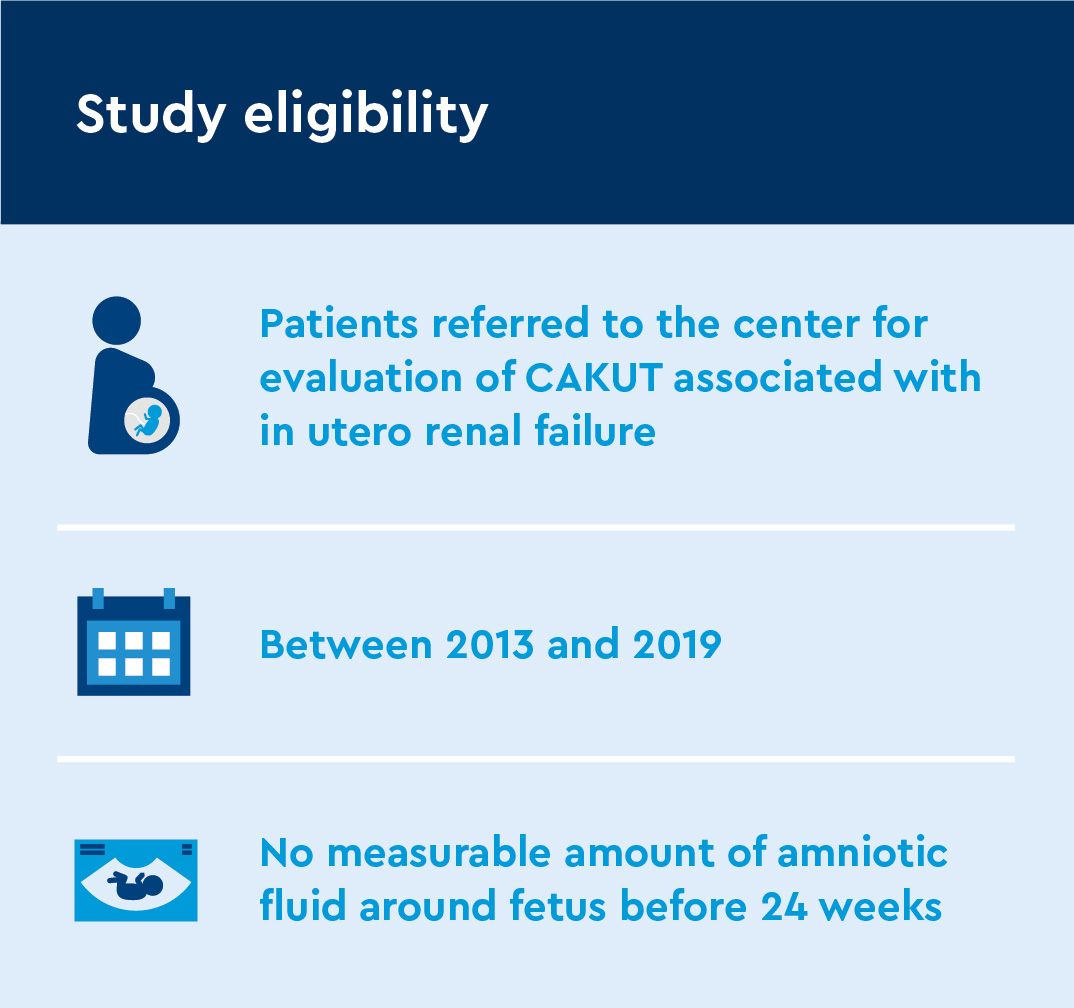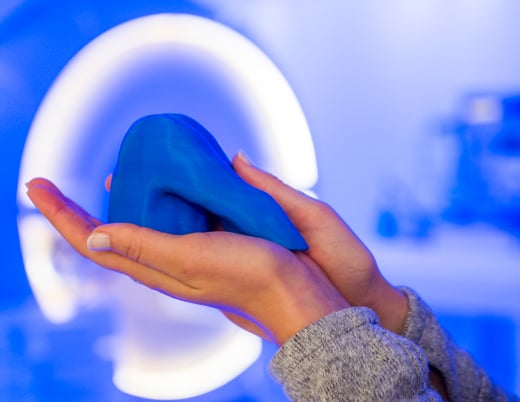Key takeaways
-
Risks, benefits and outcomes data are lacking for serial amnioinfusion intervention in fetuses with congenital anomaly of the kidney and urinary tract.
-
This study presents detailed clinical course and postnatal laboratory data not shared in previously published cases.
-
With no national guidelines, Colorado Fetal Care Center and pediatric urology researchers presents their approach for this experimental treatment.
Renal agenesis or a significant congenital anomaly of the kidney and urinary tract (CAKUT) causing in utero renal failure impact the production of amniotic fluid, which is critical for lung development. Renal agenesis or CAKUT are often considered fatal diagnoses since babies with these conditions are typically stillborn or die shortly after birth.
There have been a few reports of successful fetal intervention with amnioinfusion, but risks, benefits and outcomes data are lacking.
In this retrospective study, researchers Nicholas Behrendt, MD, Regina Reynolds, MD, and Vijaya Vemulakonda, MD, at the Colorado Fetal Care Center and the Department of Pediatric Urology at Children’s Hospital Colorado report on their experience with fetal intervention for anatomic or functional renal agenesis in five infants between 2013 and 2019.
Multidisciplinary approach
The Colorado Fetal Care Center is located within Children’s Colorado, a high-volume tertiary referral center. The center specializes in diagnosing and treating complicated fetal conditions. The multidisciplinary team includes maternal fetal medicine, pediatric urology, pediatric nephrology, neonatology, pediatric cardiology, social work, psychology, genetics, fetal radiology, transplant, pediatric anesthesia and ethics.
The center’s approach to fetal intervention includes a holistic evaluation of medical, psychosocial and ethical considerations. While there are currently no guidelines regarding amnioinfusion, multidisciplinary discussions with patients to help determine if fetal intervention is an option include:
- Diagnosis
- Prognosis
- Available pregnancy options/eligibility
- Post-birth hospitalization
- Future need for dialysis and renal transplant
- Sufficient social support
Eligibility criteria and amnioinfusion approach
Amnioinfusion approach
- First amnioinfusion scheduled before 24 weeks
- Normal saline or lactated ringers infused as needed to obtain “normal” amniotic fluid volume
- After reaching oligohydramnios, another infusion performed at provider's discretion
Case Review: Five fetuses with anatomic or functional renal agenesis underwent amnioinfusion intervention.
Case 1: Female infant born at 35 weeks
Prenatal diagnosis and treatment
- Referred to the center at 21w6d
- MRI and ultrasound findings
- Anhydramnios
- Absent bladder
- Bilateral renal agenesis
- 10 amnioinfusions from 23w2d to 31w2d
- Developed amnion-chorion separation after 10th infusion
Birth and perinatal, neonatal interventions
- Emergent C-section; birthweight 2 kg
- Infant required resuscitation with continuous positive airway pressure (CPAP) within five minutes
- Intubation
- Mechanical ventilation
- Ultrasound confirmed bilateral renal agenesis
- Extubated to room air on day 5 of life
- Peritoneal dialysis catheter was placed two days after birth but unsuccessful
- Central venous catheter for continuous renal replacement therapy (CRRT)
- Cardiopulmonary arrest caused by CRRT circuit clot on day 26 of life; resuscitation required
- Peritoneal dialysis successful after 14 days
- Discharged at 45 days of life on nightly peritoneal dialysis, weight 2.45 kg
Post-discharge to present
- Patient now 4 years old, weighs 14.6 kg
- Under evaluation for kidney transplant
- Nightly home peritoneal dialysis
- Developed several medical complications
Case 2: Female infant born at 35 weeks
Prenatal diagnosis and treatment
- Referred to the center at 21w6d
- MRI and ultrasound findings
- Oligohydramnios
- Absent bladder
- Bilateral renal agenesis
- 18 amnioinfusions from 22w5d to 34w6d
- PPROM at 33w4d with no active labor
- Mother was admitted and treated with betamethasone and antibiotics
Birth and perinatal, neonatal interventions
- Induced vaginal delivery at 35 weeks; birthweight 2.4 kg
- Infant required CPAP resuscitation after 5 minutes of life; intubated at 8 minutes of life and placed on mechanical ventilation
- Ultrasound confirmed bilateral renal agenesis
- Peritoneal dialysis catheter placed on day 1 of life, two revisions required
- Developed peritonitis
- Ongoing difficulty obtaining adequate ultrafiltrate volumes due to poorly functioning peritoneal membrane
- CRRT hemodialysis attempted several times
- Not well tolerated
- Frequent secondary clotting
- 2.56 kg weight at 1 month postpartum
- Discharged home at 73 days of life for comfort care after aggressive attempts at peritoneal dialysis
Post-discharge to death
- Family did not pursue aggressive care due to complicated course, implemented do not resuscitate order
- Infant died at 3 months secondary to:
- respiratory failure
- hyperkalemia
- dehydration
Case 3: Female infant born at 24 weeks and 1 day
Prenatal diagnosis and treatment
- Referred to the center at 20w3d
- MRI and ultrasound findings
- Intrauterine growth restriction
- Bilateral renal agenesis
- Oligohydramnios
- 3 amnioinfusions from 21w2d to 23w3d; no complications
- Mother admitted for preterm labor at 24w1d
Birth and perinatal death
- Spontaneous premature vaginal delivery; birthweight 0.460 kg
- Abnormal placenta and cord avulsion noted
- Parents chose comfort care management
- No respiratory intervention or laboratory measures
- Infant expired 12 minutes after birth
Case 4: Female infant born at 28 weeks and 4 days
Prenatal diagnosis and treatment
- Referred to the center at 22w6d
- 15 amnioinfusions from gestational ages 22w6d to 28w1d; no complications
- Mother presented with preterm labor at 28w4d
Birth and perinatal death
- Spontaneous premature vaginal delivery with partial breech extraction; birthweight 1.045 kg
- Infant was spontaneously breathing and required no resuscitation
- No laboratory measures were collected and not eligible for dialysis
- Parents chose comfort care
- Cause of death:
- Respiratory failure secondary to prematurity
- Renal agenesis
Case 5: Male infant born at 32 weeks and 5 days
Prenatal diagnosis and treatment
- Referred to the center at 17 weeks
- MRI findings
- Anhydramnios
- Full bladder
- Dilated posterior urethra
- Hydroureter
- Ascites
- Bladder outlet obstruction leading to renal failure
- 1 successful amnioinfusion occurred at 17 weeks
- Leaking of fluid consistent with PPROM day after first shunt placement
- Repeat shunt procedures attempted when leaking ceased, patient was stable
- Fluid not maintained within intra-amniotic space
- Mother admitted three times for PPROM; given betamethasone
- Mother presented at 32w5d in active labor, completely dilated; infant frank breech
Birth, perinatal intervention and death
- C-section delivery under endotracheal anesthesia; birthweight 1.76 kg
- Birth complicated by anterior uterine, cervical, vaginal lacerations requiring extensive repair, urology consult
- Infant showed minimal respiratory effort; required respiratory intervention with Neopuff mask ventilation and intubation with mechanical ventilation at 4 minutes of life
- Multiple bilateral tension pneumothoraxes, resolved by chest tubes
- Multiple resuscitation efforts when infant went into cardiorespiratory arrest
- Life-sustaining support withdrawn due to poor prognosis
- Infant expired on day 1 of life
Case series key findings
Study looked at 5 fetuses with anatomic or functional renal agenesis who underwent fetal intervention with serial amnioinfusion:
- Average maternal age: 29 years old
- Average gestational age at referral to the center: 20.2 weeks
- Average amnioinfusions before birth: 9.4
- Average gestational age at birth: 31.6 weeks
- 60% 1-month postpartum mortality rate
- 3 expired on day 1 of life
- 1 expired at 3 months
- 80% 1-year postpartum mortality rate
Discussion: Serial amnioinfusion challenges mortality of in utero renal failure, but morbidly and mortality still high.
There are no data to suggest that serial amnioinfusion for in utero renal failure provides any long-term benefit.
Two patients survived to peritoneal dialysis, both with complications.
- Comparable cases in literature demonstrate similar problems with peritoneal dialysis, failure of dialysis is often cited as leading cause of death
- Dialysis is a necessary bridge to renal transplant for functional renal agenesis, but a barrier to long-term survival
Vaginal leaking of intra-amniotic fluid is a frequent finding in serial amnioinfusion and caused a significant barrier in two cases. If amnioinfusion is successful but vaginal fluid leaking and anhydramnios occurs within 72 hours, the center does not usually continue infusions because there is no likely benefit.
The sole long-term, 4-year-old survivor awaits renal transplant while on nightly home peritoneal dialysis.
- Developed over a dozen comorbidities related to renal agenesis and dialysis, will require urinary diversion for absent bladder
- Cognitively on track but behind on motor skills
Serial amnioinfusion has challenged the lethality of in utero renal failure but morbidity and mortality remain high at this stage of this evolving therapy. Large-scale multicenter trials can help:
- Determine validity of the intervention
- Guide fetal centers in optimizing ideal candidates
Conclusion: Serial amnioinfusion should be considered experimental.
Individuals carrying a pregnancy complicated by CAKUT anomalies face a difficult choice when considering intervention in the setting of a natural history of 100% mortality without prenatal therapy. Intervention is associated with significant morbidity and mortality. The Renal Anhydramnios Fetal Therapy (RAFT) Trial bilateral renal agenesis arm recently concluded with data consistent with what is presented in this study. Serial amnioinfusion is effective in providing pulmonary survivors, however, due to the implications and reduced birthweight resulting from prematurity, neonatal dialysis is very challenging and resultant mortality is high. Improved outcomes will likely occur with technology advancements that allow for dialysis in smaller and premature neonates. Findings by the study authors underscore treatment of these cases should be considered experimental and further research is needed.
Featured Researchers
Nicholas Behrendt, MD
Maternal fetal medicine specialist
Children’s Hospital Colorado
Associate professor
Ob/Gyn-Maternal Fetal Medicine
University of Colorado School of Medicine

Regina Reynolds, MD
Neonatal specialist
Neonatal Intensive Care Unit
Children's Hospital Colorado
Associate professor
Pediatrics-Neonatology
University of Colorado School of Medicine

Vijaya Vemulakonda, MD
Pediatric urologist
Department of Pediatric Urology
Children's Hospital Colorado
Professor
Surgery-Urology
University of Colorado School of Medicine





 720-777-0123
720-777-0123











